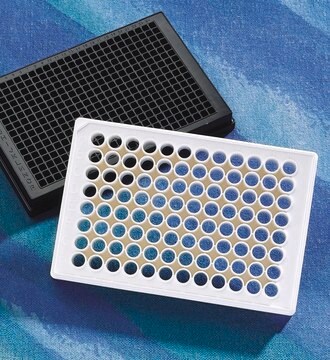A-003-M
Poly-ᴅ-Lysine Hydrobromide
synthetic, liquid, 1 mg/mL, suitable for cell culture
Sinónimos:
poly lysine
About This Item
Productos recomendados
Nombre del producto
Poly-D-Lysine solution, 1.0 mg/mL, The Poly-D-Lysine solution promotes the adhesion of tissues/sections to the culture vessel.
biological source
synthetic
Quality Level
form
liquid
manufacturer/tradename
Specialty Media
technique(s)
cell culture | mammalian: suitable
input
sample type neural stem cell(s)
sample type epithelial cells
sample type: human embryonic stem cell(s)
sample type hematopoietic stem cell(s)
sample type mesenchymal stem cell(s)
sample type pancreatic stem cell(s)
sample type induced pluripotent stem cell(s)
General description
Application
- To coat culture vessels and provide a suitable surface for the growth and attachment of neuronal cells.
- In preparing the surface of coverslips for facilitating the attachment of non-adherent cells.
Biochem/physiol Actions
Features and Benefits
- Poly-D-Lysine (PDL) solution is diluted in phosphate buffer saline (PBS), water, or 0.1M borate buffer.
- Working dilutions of 50μg/mL to 100μg/mL are usually adequate.
- It has a surface coverage of 3-10μg/cm2.
- PDL can be stored at -20 ˚C for up to 18 months.
- Plates are coated for 3 hours overnight and up to 3 days when stored at 4˚C.
- PDL-coated plates are used immediately or stored in PBS for up to 5 days.
Physical form
Preparation Note
Storage and Stability
Storage Class
12 - Non Combustible Liquids
wgk_germany
nwg
flash_point_f
Not applicable
flash_point_c
Not applicable
Certificados de análisis (COA)
Busque Certificados de análisis (COA) introduciendo el número de lote del producto. Los números de lote se encuentran en la etiqueta del producto después de las palabras «Lot» o «Batch»
¿Ya tiene este producto?
Encuentre la documentación para los productos que ha comprado recientemente en la Biblioteca de documentos.
Los clientes también vieron
Artículos
Extracellular matrix proteins such as laminin, collagen, and fibronectin can be used as cell attachment substrates in cell culture.
Nuestro equipo de científicos tiene experiencia en todas las áreas de investigación: Ciencias de la vida, Ciencia de los materiales, Síntesis química, Cromatografía, Analítica y muchas otras.
Póngase en contacto con el Servicio técnico








